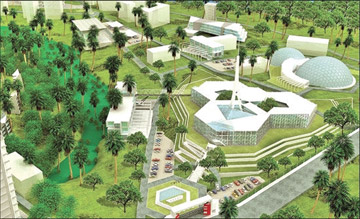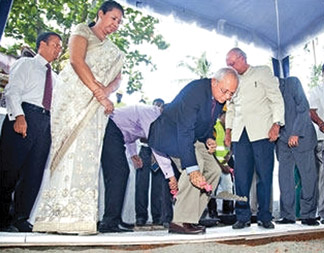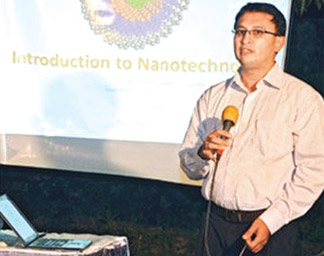|
Sri Lanka as a leading nanotechnology destination:
A step towards the future
By Shirajiv SIRIMANE
Sri Lanka had been talking of introducing nanotechnology for almost
15 years; ministers had promised to build nano parks and provide other
benefits to get such projects off the ground. However, very little
attention had been paid to the matter.
 |
|
A model of the
Nanotechnology Centre in Homagama |
Last Thursday, the much talked about and long overdue foundation
stone for the 54-acre nanotechnology Centre of Excellence (NCE) was
finally laid on Government land at Homagama.
Chairman Sri Lanka Institute of Nanotechnology (SLINTEC), Mahesh
Amalean said the investment for the initial stage of the project is Rs
830 million. The nanotechnology park, funded by the Government and a few
private sector entities, would enable companies to invest and develop
their research centres’ incubation facilities and pilot plants in the
environment of an advanced technology park.
This would help Sri Lanka to be positioned as a leading destination
for nanotechnology, taking the country closer towards becoming the
‘Wonder of Asia’.
The second phase of the park will focus on the expansion of research
and business development for the public and private sector in Sri Lanka
and potential foreign direct investment from multinational corporations
as well as SMEs through attractive incentives, terms and conditions.
Nanotechnology Goldmine
One of Asia’s leading nano-scientists Dr Lalin Samaranayake told the
Sunday Observer that Sri Lanka is sitting on a ‘nanotechnology
goldmine’. It has not used its potential in the world market, he said
He said while Sri Lanka has the technology to reap economic benefits
from nanotechnology in the island itself, the country only exports raw
materials, giving all the benefits to the world. “Sri Lanka sells nano
raw materials such as graphite, silica, titanium dioxide and clay for
various industries in the world and imports the finished products
spending a lot of foreign currency.”
Sri Lanka now has an opportunity to add premium value to its raw
materials through research and development work in nano-technology by
local scientists and engineers. For example, processes have been
designed and developed to produce titanium dioxide and nano titanium
dioxide which will save more than 10 times the foreign exchange spent on
importing them for local industries.
Nanotechnology is considered a key technology for the future.
Consequently, various governments have invested billions of dollars in
its future. The USA has invested US$ 3.7 billion through its National
Nanotechnology Initiative followed by Japan with US$ 750 million and the
European Union US$ 1.2 billion.
 |
|
Minister of Technology and Research
Pavithra Wanniarachchi and Chairman, Sri Lanka Institute of
Nanotechnology, Mahesh Amalean lay the foundation stone for
the Nanotechnology Centre |
 |
|
Nano-scientist Dr.
Lalin Samaranayake |
Nanotechnology may be able to create many new materials and devices
with a vast range of applications, such as in medicine, electronics,
bio-materials and energy production. In addition, methods have been
invented and patented to produce carbon nano tubes of high quality and
purity which have a market price of about US $ 500 per gram whereas
currently the raw graphite is exported from local mines at US$ 1,200 per
metric tonne.
High quality products
Hence, the knowledge base and technology drive have been created and
instated in-house and it is time to invest on them with a vision and put
into practice measures where nanotechnology- based high quality products
with ‘Made in Sri Lanka’ labels reach the global market.
“That way we shall not be very far from economic prosperity,” he
said. He said one of the biggest advantages of nanotechnology is that it
uses a low investment and brings high returns. Nanotechnology also
consumes low levels of electricity and factories do not need large
areas.
“This makes nano a viable investment for the private sector,” he
added.
Another major advantage is that raw materials to produce nano tubes
and other export telecast material would be freely available even for
another century. Samaranayake, who is based in Sweden, said the recent
Budget has provided incentives for research which is a very good
initiative.
Budget 2012
Today there is increasing confidence among policymakers that research
and development can make a significant contribution towards achieving
development goals.
This is clearly reflected in the 2012 budget, said Minister of
Technology and Research Pavithra Wanniarachchi.
“A few years ago, President Mahinda Rajapaksa, together with the
Treasury, took a leap of faith in nanotechnology. We are now witnessing
the results of this foresight and vision for our country,” said the
Minister.
Recently, the SLINTEC in a landmark agreement, entered into a
strategic collaboration with Nagarjuna Fertilisers and Chemicals Limited
of Hyderabad, India, to develop the next generation of
nanotechnology-based plant fertiliser solutions. It was the first
program which provided Lankan technology to the international market,
SLINTEC science team leader, Professor in Chemistry, University of
Peradeniya, Professor Veranja Karunaratne said. The main purpose of this
agreement is to develop the next generation of nanotechnology-based
plant nutrition solutions.
|

